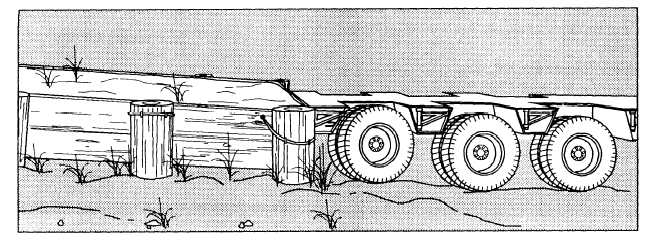Figure 7-30.—Permanent loading ramp.
from damage by chafing (rubbing together) with
cardboard, paper, cloth, or other filler.
Loading Equipment
Loading equipment onto a trailer is dangerous. In
most cases the equipment will be just as wide as the
trailer with a little room for error. Always use a guide to
ensure that the equipment is on the trailer straight and
that you do not run it off the trailer.
Regardless of what type of equipment you are
loading or what type of trailer you are using, there are
general rules that apply. The rules are as follows:
1. Have the equipment in line with the trailer and
the transmission placed in low gear. Increase the throttle
of the tractor just high enough to have power to pull itself
onto the trailer.
2. Watch and follow your guide.
3. Do not steer sharply.
4. Do not stop except for an emergency.
5. For crawler machines only, move slowly at the
top of any ramp or a jarring fall can result when the
machine is past the balance point.
6. Center the equipment on the trailer to load the
truck-tractor and trailer axles evenly.
LOW-BED TRAILER.— When loading a low-bed
trailer with a self-propelled machine, you must use a
ramp, blocks, bank or pile of dirt, or a ditch.
Portable ramps are heavy and hard to handle and
require as many as four people to lift, carry, and set up.
In most equipment yards, a permanent ramp is
constructed of timber or concrete (fig. 7-30) to support
the loading and unloading of equipment.
Blocks can be used to load crawler equipment but
are not recommended for wheeled equipment. Use
blocks if you have nothing else; however, be cautious
because the machine will be at a greater angle than
desired when the balance point is met (fig. 7-31.)
When a trailer can be backed against a bank or into
a ditch, you may load or unload without the use of
ramps.
When you have to load a machine and you do not
have ramps, blocks, or ditches, you may have to push
up a pile of dirt from which to load. Do not dig a hole
in finish grade or any place you would have to smooth
out. But, if you do push up a pile of dirt for a ramp,
ensure the ramp angle is not too steep (3 feet out for
every 1 foot up). Ensure the ramp is wider than the trailer
and somewhat compacted to support the ground-bearing
pressure of the equipment.
TILT-BED TRAILER.— A tilt-bed is like having
portable ramps all the time. The bed will tilt (fig. 7-32)
for the load to move up and forward of the balance point.
As the load continues to move forward, the bed lowers
into the transport position. Ensure the tilt-bed locking
device and safety lock, as shown in figure 7-6, are
opened before the bed is lowered.
WARNING
When using a tilt-bed trailer to haul equip
ment, do not attempt to load or unload equip-
ment from a ramp or dock as would be
performed when using a low-bed trailer. This
action is dangerous and causes severe damage
to the tilt-bed trailer and the tilt-bed deck-
locking mechanism.
7-26


